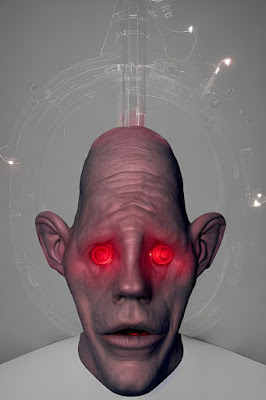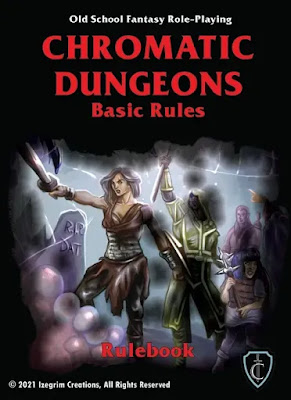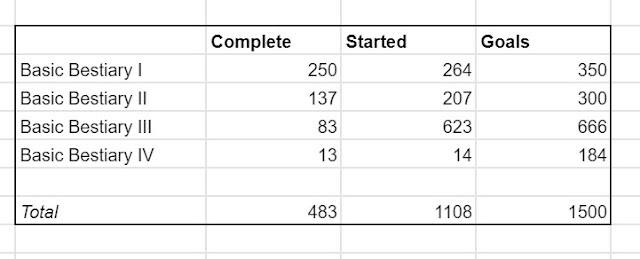Today I am talking with Roderic Waibel the creator of Chromatic Dungeons which is in the middle of its Kickstarter. Which you can find here: https://www.kickstarter.com/projects/1693797308/chromatic-dungeons?theotherside
Tim Brannan/The Other Side: Let’s start at the beginning, who are you and what do you do?
Roderic Waibel: I started gaming in 1981 with the Basic Set, and quickly fell in love and moved to AD&D. Been involved in RPGs every day since, from the first map I drew as a kid, to my first game I wrote in 1986 (I still have a copy of that, and it’s...nothing to be proud of lol). I’m a project manager as a day job, but have been an indie publisher officially for the past 10 years or so.
TB/TOS: You mention in your bio you have been writing RPGs since 1986. Anything, in particular, you want to share? What are some of your past hits?
RW: My biggest commercial success would have to be Compact Heroes. During my time in the military, portability was a big thing. It’s one of the reasons why MtG took off for servicepeople; you could easily take it with you while full rulebooks were hard to do that. So I created a card game that played like a traditional role-playing game. That won DieHard Gamefan’s Best New Game of the Year in 2011 when it came out. There are other things I’ve created that I like, but most of those were homebrew systems that never took off. Let’s be honest, most never do. Why would someone who doesn’t know me want to play a homebrew system when they have so many officially supported systems out there. They were all pretty much vanity games. The only other product that has done pretty well is the megadungeon: Depths of Felk Mor. I wrote that right when the 5e playtests came out, and is 5e compatible. It’s written in an old school aesthetic, and chock full of 80s pop culture references lol. Kind of a mix between Cthulhu and 80s cartoon hour. Yes, that’s a thing lol.
TB/TOS: What are some of your favorite games? Why?
RW: RPGs are my all-time favorite because I’ve always been very creative and love to imagine things. Strategy games probably come in second place. I always have a fond soft spot for Axis&Allies in the non-RPG genre.
TB/TOS: Fantastic. Now tell everyone a little bit about your game
Chromatic Dungeons.
RW: Old school D&D was and is my favorite edition. Not just for nostalgia (admittedly that is part of it, but a small part), but also because of the kind of experience it lends to. Rulings over rules, speed of play, zero to hero, player creativity and strategy (you can’t assume every encounter should be winnable which is something I see a lot in modern games), etc. However, it was a product of its time. That is, catered and marketed to white young males. As a young white male myself at the time, of course I never noticed anything problematic. This isn’t a dig at any of the creators of the game, or any of the players of the game. It was what it was at the time with what we considered socially OK. But as we’ve grown as a community over the years, we’ve become incredibly diverse. That diversity should be represented and included. People other than straight white men like myself should be able to pick up the game and see themselves represented in it. Studies have shown, over and over, how a diverse group is much more efficient and beneficial than a monocultural one. I’ve hired a lot of diverse freelancers and editors for this, and I can tell you that the game is much better for it.
Then you’ve got lessons learned mechanically over the past decades we can rely on that should be applied. Things like ascending armor class that are more intuitive rules.
These two factors together were the driving force behind Chromatic Dungeons. Currently there is a lot of drama going on regarding comments some of the folks who call themselves OSR or old school have made with the new re-branding of TSR. But that isn’t what caused Chromatic Dungeons to come about. Comments like those folks are making the news now because they are big names, but the fact is that for a long time, the OSR community has had to deal with a large portion of fans who have been espousing exclusionary opinions. I firmly do NOT believe the OSR itself is like that, or that most fans are like that. But it’s a problem that needs to be addressed because there is a reputation the OSR is getting, and it’s not good. We can’t deny that. And as a fan of the OSR, I will do what I can to show how the OSR can also be welcoming and inclusive.
Thus, about six months ago, Chromatic Dungeons was born in its first iterations. It’s basically a game that captures the best things about B/X, 1e, and 2e, while applying modern sensibilities and lessons learned since then, and being presented in an old-school aesthetic that represents how diverse our gaming hobby has become.
TB/TOS: What do you feel makes Chromatic Dungeons a step above or better than say current Clones on the market now? What do you think makes it special? Or bottom line, why should people want to buy this game?
RW: Having fun is the best reason to play a game, right? That’s the ultimate goal? Many clones out there try to replicate the rules of those older versions extremely closely. But as anyone who played back then will tell you, many of the rules got in the way. We simply ignored them. Chromatic Dungeons applies some mechanical changes to help alleviate that. The first and most obvious is the move to ascending Armor Class. But then you’ve also got a revision to alignment, making it much less impactful in regards to driving a PC’s behavior or moral code. It’s a cosmic force that acts as an influence, not a strict moral code you have to follow. Traditional racial traits have been re-done as well. Now those choices only give a few traits, but there is a heritage system instead that anyone can choose that gives you traditional racial bonuses. For example, you can choose to play a human with the fey heritage (let’s say they grew up in an elven city), so they can gain resistance to sleep and charm, two traits traditionally reserved only for elves. Another change is getting rid of dead levels. While not being a robust customized able system like feats were in 3e (that would defeat the purpose of having a streamlined system like b/x), each class does offer something other than a hit point gain at most levels.
And then of course there’s the presentation. The game is presented to be welcoming and inclusive of everyone. Making everyone welcome is always a good thing, as it grows our hobby and keeps it alive.
TB/TOS: You list a few differences from older games on the Kickstarter site. What was your driving motivation behind these?
RW: I guess I answered that above. I tend to ramble lol. The key goal is to capture the feel of gaming back then, but rules changes can be made as long as that goal isn’t compromised. You should be able to pick up an old module from the 80s and play Chromatic Dungeons with very little conversion. You should be able to do it on the fly, actually. That’s important for me to keep. People have a plethora of material from the old days, and they should absolutely be able to use it with Chromatic Dungeons.
TB/TOS: The Character sheet looks fantastic and has a great old-school feel to it. What things from the older games did you want to retain?
RW: The most important is speed of play and player skill. Players shouldn’t feel discouraged from attempting something with their PC if they don’t have a skill for it. The less a player references a character sheet, and the more they go to their imagination to describe what they want, the better. Keeping players engaged is important. However, if players don’t prefer to use player skill for whatever reason, they can fall back on a skill system that is incredibly simple. It’s a roll under ability system. If your PC wants to jump up to the chandelier and swing across the room, they don’t need an acrobatics skill to do that. Simply roll the d20 and if it’s under your Dexterity score, congrats! This system also makes every point in an ability count. A gripe of mine from the current system is that there is no difference between a 14 and 15 ability score.
TB/TOS: What sorts of games do you see others playing with these rules?
RW: Like all old-school games, I see people taking bits and pieces of this and applying it to their own games. Most old-school gamers are also big into homebrewing. Back in the day, we all created our own worlds and adventures, and I don’t see that as much now. So I can easily see someone taking an old adventure module and playing Chromatic Dungeons with it. Or taking the heritage system out of CD and using it for their OSE game.
TB/TOS: Who would you say Chromatic Dungeons is for?
RW: Everyone. I know that sounds cliche, but it’s true. It’s a big driver behind the whole project. Everyone should feel like they can play this. However, and there’s always a however, I fully understand that some folks might not find the appeal. And that’s totally OK. We all have different preferences, and there is no one-true-way to play the game. For example, because the game is streamlined, optimizers might not be drawn to it because there isn’t the level of customization options as 3e. If you were to force me to answer, I’d say this game is especially for those who want a classic feel of gaming with modern design sensibilities, and who were traditionally not represented in those older games. But really, anyone who enjoys the style of old school gaming, regardless of the diversity or lack thereof, should enjoy this game. Because the game makes a point to represent people of every demographic doesn’t mean it excludes the traditional straight white male (I would be excluding myself!). Yes, I’ve heard that complaint as well.
I will add this: Because no intelligent mundane humanoid has a default alignment in Chromatic Dungeons, there are several people who I’ve heard say this game excludes people who just want the old way of doing things, where all orcs are evil. I want to be very clear that in CD, you absolutely can still do that. I’m not showing up to anyone’s house to “cancel” them. It’s just not the default assumption anymore. But you as a GM can do whatever you want, and play them however your table feels like. That’s still a perfectly valid way to play the game.
TB/TOS: What are your future plans for this game?
RW: The immediate plans are to put out a monthly Zine that offers new material. Think of it like a mini-Dragon magazine from back in the day. The first four are already done, and part of the Kickstarter as a matter of fact. Writing the fifth one now (really expanding on orcs, their various cultures, etc).
TB/TOS: And finally, for the benefit of my audience, well and me, who is your favorite witch or magic-using character?
RW: The second fantasy novel I read after the Book of Three was Sword of Shannara. So Allanon has always had a soft spot in my heart.
I want to add one final note regarding this campaign. It’s important for me to walk the talk. It’s one reason why I made it a point to hire diverse freelancers and editors. This isn’t mentioned on the Kickstarter page because Kickstarter cannot be used as a fundraiser for charities, but I have committed to matching 25% of net profits and donating that to The Trevor Project. That’s a great charity that helps at-risk LGBTQ youth, and to give them the support they need. So by supporting this project, you’re not just getting a great RPG, you’re helping at-risk youth who deserve to be treated better than our society does.
Links
Chromatic Dungeons Kickstarter
Izegrim Creations
DriveThruRPG



















